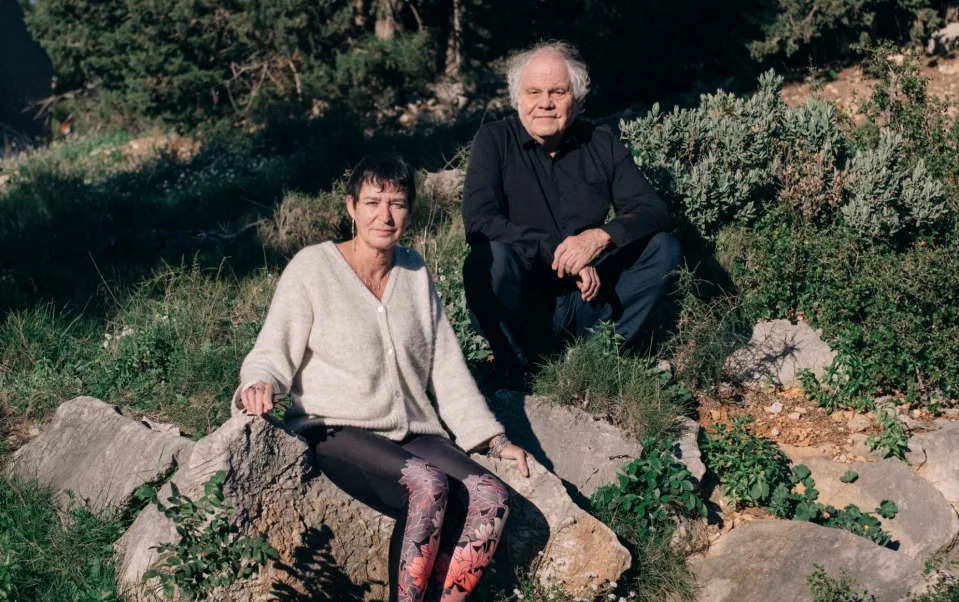Jacob Phillips
Sat, 17 February 2024
Twelve people have been arrested at a pro-Palestine demonstration in central London.
The arrests were for a string of alleged offences, including inciting racial hatred, suspicion of support for a proscribed organisation in relation to a placard, and assaulting emergency workers.
But the Metropolitan Police said the "overwhelming majority" of people who took part were peaceful and acted lawfully.
Between 200,000 and 250,000 people were expected at the demonstration, according to a spokesman for the Palestine Solidarity Campaign.
Protesters met at the south of Park Lane, holding banners calling for a “ceasefire now” and chanting “free, free Palestine”, before leaving for designated place near the Israeli embassy where speeches would be made.
Among the speakers was former Labour leader Jeremy Corbyn and Palestinian ambassador to the UK Husam Zomlot, who both called for “justice” for the Palestinian people.

Pro-Palestinian activists and supporters wave flags and carry placards during the march (AFP via Getty Images)
The Islington North MP also told the crowd he will be voting in support of a ceasefire motion being held by Westminster next week, due to be tabled by the Scottish National Party.
Before the march began at 1.30pm, the Metropolitan Police announced on X, formerly Twitter, that officers had arrested one person on suspicion of support for a proscribed organisation in relation to a placard.
About two hours later they tweeted: “Officers have made nine further arrests during an incident at Hyde Park Corner.
“A man was seen in the crowd with an antisemitic placard. He has been arrested for inciting racial hatred.
“When officers went in to arrest him they were assaulted, resulting in six arrests for assaulting an emergency worker.
“Two other people were arrested for refusing to remove face coverings when required to do so by officers under Section 60AA of the Public Order Act.”

Pro-Palestinian activists and supporters in central London (AFP via Getty Images)
At around 4pm, the Met announced one further arrest “for an antisemitic placard”, bringing the total number of arrests so far to 11.
The force explained that the Section 60AA order requires anyone wearing a face covering “for the purpose of concealing their identity” to remove it when asked to do so.
It was in force until 8pm in a designated area.
Just before 6.30pm the Met posted on X, formerly Twitter: "Today's protest has now fully concluded.
"There were 12 arrests for placard related offences, assaults on officers and refusal to remove face coverings. Thankfully, none of the officers who were assaulted were seriously injured.
"Despite these arrests, the overwhelming majority who took part were peaceful and acted entirely with the law. We worked closely with the organisers and their stewarding team in the run up to and during the protest and we're grateful for their cooperation."
A Section 35 dispersal order is in place until 11pm, meaning anyone refusing a direction to leave the area can be arrested.
Police also stopped a "pro-Palestinian car convoy" in Neasden, north-west London, and monitored it to ensure it was not "causing fear".
Mr Corbyn took to the stage amid raucous applause, telling the crowd: “We’ve got to carry on. This is the 14th national demonstration and there’s going to be as many more as it takes until there is a ceasefire, until there is justice for the Palestinian people.”
He added: “We’re witnessing something globally horrific in real time on our televisions.
“And so on Wednesday, when the UK Parliament has a motion before it tabled by the Scottish National Party, I am signing in support of that motion.
“And I want every one of you here demand, demand of your MP, your elected representative, be there, vote for a ceasefire.

A Pro-Palestinian supporter waves a Palestinian flag (AFP via Getty Images)

A Pro-Palestinian supporter poses with a placard (AFP via Getty Images)
“No ifs, no buts, no qualifications.”
Mr Zomlot told the crowd: “You see what is happening, you are horrified at what is happening, you are shocked to your core at the inaction of your government.
“Hang on to your anger, hang on to your enragement, hang on to your horror and use it, use it in the pursuit of justice.”
At least 28,663 Palestinians have been killed in Gaza since Israel began its military operation in the strip in October in response to the October 7 attacks, where militants killed some 1,200 people and took another 250 hostage.
Israel is being urged not to send ground forces into Rafah on the Egyptian border, where many of the strip’s citizens are now living after areas closer to their homes became engulfed by fighting.
Twelve arrested at pro-Palestine march near Israeli embassy in central London
Matt Mathers
Sat, 17 February 2024
Twelve people were arrested at a pro-Palestine march in central London on Saturday afternoon which called for an immediate ceasefire in Gaza.
The arrests were for a string of alleged offences, with one person detained on suspicion of support “for a proscribed organisation in relation to a placard”.
Others were arrested for alleged assaults on officers and refusal to remove face coverings. The Metropolitan Police said none of the officers who were assaulted were seriously injured.
The Palestine Solidarity Campaign said that between 200,000 and 250,000 attended the demonstration, which started at the south side of Marble Arch at 1.30pm. The Metropolitan Police said the “overwhelming majority” of people who took part were peaceful and acted lawfully.
Demonstrators held banners calling for a “ceasefire now” and chanted “free, free Palestine” in the streets of the capital. Jeremy Corbyn, the former Labour leader, was among those who spoke at the march. The Islington North MP told the crowd he will be voting in support of a ceasefire motion at Westminster next week, to be tabled by the SNP.
Taking to the stage amid raucous applause, Mr Corbyn told the crowd: “We’ve got to carry on. This is the 14th national demonstration and there’s going to be as many more as it takes until there is a ceasefire, until there is justice for the Palestinian people.”
Saturday’s demonstration was the second time since the 7 October terror attacks by Hamas that a pro-Palestine protest has taken place near the Israeli embassy.
A static rally was held near the embassy on 9 October. Police said the start time allowed for a synagogue event to finish.

People take part in a pro-Palestine demonstration in central London (PA Wire)
The Met said “there will be some who ask why” a decision to allow the protest so close to the embassy was allowed but that it is a “common misconception” that forces can allow or refuse permission for a protest to take place.
“A real risk of serious disorder” sufficient for the Met to request that the home secretary ban the protest has not been seen at recent demonstrations, the force added.
The march set off along Park Lane and continued to Knightsbridge and Kensington Road, ending at the junction with Kensington Court where the speeches took place.
Around 1,500 police officers from forces across the UK were on public order duties during the demonstration.
Protesters were kept more than 100m away from the embassy grounds, behind barriers controlled by officers and faced arrest if they tried to get closer.

About 1,500 police from forces across the UK were on duty during the demonstration (PA Wire)
Conditions under Section 12 of the Public Order Act mean that any person participating in the march must not deviate from the route.
Police also said no gazebos or other stalls were allowed to be erected in a specified area at Marble Arch.
Two other people were arrested for refusing to remove face coverings when required to do so by officers under Section 60AA of the Public Order Act.
Just before 6.30pm the Met posted on X, formerly Twitter: “Today’s protest has now fully concluded.
“There were 12 arrests for placard-related offences, assaults on officers and refusal to remove face coverings. Thankfully, none of the officers who were assaulted were seriously injured.
“Despite these arrests, the overwhelming majority who took part were peaceful and acted entirely within the law. We worked closely with the organisers and their stewarding team in the run up to and during the protest and we’re grateful for their cooperation.”
The force had imposed Section 60, 60AA and 35 orders, giving police additional powers. The Section 60 order gave police additional search powers and the Section 60AA required anyone wearing a face covering “for the purpose of concealing their identity” to remove it when asked to do so.
The Section 35 dispersal order meant anyone refusing a direction to leave a specified area could be arrested.
Police also stopped a “pro-Palestinian car convoy” in Neasden, northwest London, and monitored it to ensure it was not “causing fear”.
At least 28,663 Palestinians have been killed in Gaza since Israel began its military operation in the strip in response to the 7 October attacks, where militants killed some 1,100 people and took another 250 hostage.
Israel is being urged not to send ground forces into Rafah on the Egyptian border, where 1.5 million Palestinians are now seeking refuge.
Matt Mathers
Sat, 17 February 2024
Twelve people were arrested at a pro-Palestine march in central London on Saturday afternoon which called for an immediate ceasefire in Gaza.
The arrests were for a string of alleged offences, with one person detained on suspicion of support “for a proscribed organisation in relation to a placard”.
Others were arrested for alleged assaults on officers and refusal to remove face coverings. The Metropolitan Police said none of the officers who were assaulted were seriously injured.
The Palestine Solidarity Campaign said that between 200,000 and 250,000 attended the demonstration, which started at the south side of Marble Arch at 1.30pm. The Metropolitan Police said the “overwhelming majority” of people who took part were peaceful and acted lawfully.
Demonstrators held banners calling for a “ceasefire now” and chanted “free, free Palestine” in the streets of the capital. Jeremy Corbyn, the former Labour leader, was among those who spoke at the march. The Islington North MP told the crowd he will be voting in support of a ceasefire motion at Westminster next week, to be tabled by the SNP.
Taking to the stage amid raucous applause, Mr Corbyn told the crowd: “We’ve got to carry on. This is the 14th national demonstration and there’s going to be as many more as it takes until there is a ceasefire, until there is justice for the Palestinian people.”
Saturday’s demonstration was the second time since the 7 October terror attacks by Hamas that a pro-Palestine protest has taken place near the Israeli embassy.
A static rally was held near the embassy on 9 October. Police said the start time allowed for a synagogue event to finish.

People take part in a pro-Palestine demonstration in central London (PA Wire)
The Met said “there will be some who ask why” a decision to allow the protest so close to the embassy was allowed but that it is a “common misconception” that forces can allow or refuse permission for a protest to take place.
“A real risk of serious disorder” sufficient for the Met to request that the home secretary ban the protest has not been seen at recent demonstrations, the force added.
The march set off along Park Lane and continued to Knightsbridge and Kensington Road, ending at the junction with Kensington Court where the speeches took place.
Around 1,500 police officers from forces across the UK were on public order duties during the demonstration.
Protesters were kept more than 100m away from the embassy grounds, behind barriers controlled by officers and faced arrest if they tried to get closer.

About 1,500 police from forces across the UK were on duty during the demonstration (PA Wire)
Conditions under Section 12 of the Public Order Act mean that any person participating in the march must not deviate from the route.
Police also said no gazebos or other stalls were allowed to be erected in a specified area at Marble Arch.
Two other people were arrested for refusing to remove face coverings when required to do so by officers under Section 60AA of the Public Order Act.
Just before 6.30pm the Met posted on X, formerly Twitter: “Today’s protest has now fully concluded.
“There were 12 arrests for placard-related offences, assaults on officers and refusal to remove face coverings. Thankfully, none of the officers who were assaulted were seriously injured.
“Despite these arrests, the overwhelming majority who took part were peaceful and acted entirely within the law. We worked closely with the organisers and their stewarding team in the run up to and during the protest and we’re grateful for their cooperation.”
The force had imposed Section 60, 60AA and 35 orders, giving police additional powers. The Section 60 order gave police additional search powers and the Section 60AA required anyone wearing a face covering “for the purpose of concealing their identity” to remove it when asked to do so.
The Section 35 dispersal order meant anyone refusing a direction to leave a specified area could be arrested.
Police also stopped a “pro-Palestinian car convoy” in Neasden, northwest London, and monitored it to ensure it was not “causing fear”.
At least 28,663 Palestinians have been killed in Gaza since Israel began its military operation in the strip in response to the 7 October attacks, where militants killed some 1,100 people and took another 250 hostage.
Israel is being urged not to send ground forces into Rafah on the Egyptian border, where 1.5 million Palestinians are now seeking refuge.


















